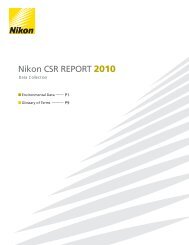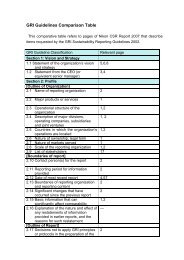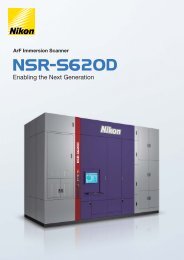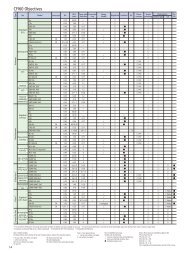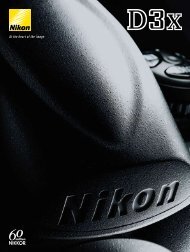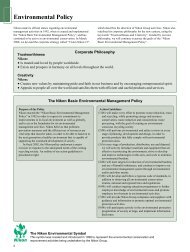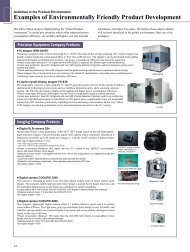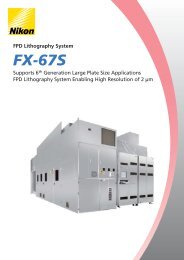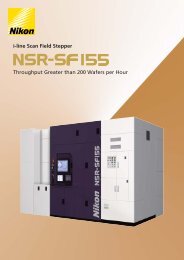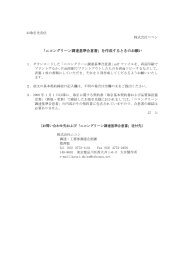Examples of Environmentally Friendly Product Development - Nikon
Examples of Environmentally Friendly Product Development - Nikon
Examples of Environmentally Friendly Product Development - Nikon
- No tags were found...
You also want an ePaper? Increase the reach of your titles
YUMPU automatically turns print PDFs into web optimized ePapers that Google loves.
Activities in the <strong>Product</strong> Environment<strong>Examples</strong> <strong>of</strong> <strong>Environmentally</strong> <strong>Friendly</strong> <strong>Product</strong> <strong>Development</strong>The entire <strong>Nikon</strong> group is implementing the “<strong>Nikon</strong> <strong>Product</strong>Assessment” to create new products which <strong>of</strong>fer enhanced powerconsumption efficiency, are smaller and lighter, use less harmfulsubstances, and utilise eco-glass. We believe these improvementswill be most beneficial to the global environment. Here are a fewexamples:Precision Equipment Company <strong>Product</strong>s• KrF excimer scanning IC stepper NSR-S206DOverall power consumption efficiency is improved thanks to the enhancements in resolution, total alignmentaccuracy and throughput combined with efforts to minimise the increase in power consumption.Design modifications made it possible to change the supported wafer from 200mm to 300mm, providingnew-generation semiconductor manufacturing capabilities without the need to replace equipment, and enablingcontinued use <strong>of</strong> existing assets. Increased by more than 120% over the NSR-S202A in exposure <strong>of</strong> a 200mm wafer (internalreference). New HFC refrigerant with zero ODP (Ozone-depletion Potential) used for temperature control andair conditioning chillers. New HFE refrigerant with low global warming potential used in equipment internal cooling.<strong>Nikon</strong> steppers lead the IC industry with highly integrated circuits, greatly contributing to revolutionary improvements inresource usage efficiency.NSR-S206DImaging Company <strong>Product</strong>s1. Film-based cameras and interchangeable lenses• <strong>Nikon</strong> F55Each component <strong>of</strong> the entire mechanism was redesigned to attain a product even more compact than the <strong>Nikon</strong> F65,which itself earned extensive praise for its small size and light weight. 9% smaller than <strong>Nikon</strong> F65 10% less than <strong>Nikon</strong> F65• Lite Touch Zoom 130ED QDAchieved major reductions in size, weight and component count by adopting a new single-motor design and smallermechanisms. 12% smaller than Lite Touch Zoom 120ED QD 10% less than Lite Touch Zoom 120ED QD 7% fewer than Lite Touch Zoom 120ED QDF55Lite Touch Zoom 130ED QD• AF Zoom-Nikkor 28-100mm f/3.5-5.6GNew optical and mechanical systems feature a simple two-group zoom that significantly reduces the component count toachieve the world's lightest AF28-100mm class zoom lens (as <strong>of</strong> June 2002). 45% smaller than AF Zoom-Nikkor 28-105mm f/3.5-4.5D IF 46% less than AF Zoom-Nikkor 28-105mm f/3.5-4.5D IF 100%AF Zoom-Nikkor 28-100mm f/3.5-5.6G2. Digital cameras• D1xConsumption <strong>of</strong> all circuits was reviewed and slashed substantially by moving to a finer ASIC design rule and switchingto an LED backlight for the LCD. 50% higher than D1• D100Streamlined circuits, downed clock rate and components with lower operating currents provided a major reduction inpower consumption. 200% higher than D1• COOLPIX 5700Lightest digital camera with a high-magnification lens and 5.0 effective megapixels. Energy-saving designfeatures dedicated EN-EL1 rechargeable batteries that provide 90 minutes <strong>of</strong> continuous operation from a fullcharge. 100%, including projection lensD1xD100COOLPIX 570012
Targets• Improvement in energy efficiency <strong>of</strong> 30% or greater for functions on products marketed during fiscal 2003,compared with products sold since fiscal 1998.• Reduction <strong>of</strong> models using ozone layer-damaging HCFC, used as refrigerant for IC and LCD steppers to fewer than30% <strong>of</strong> all products shipped in fiscal 2003, with ultimate goal <strong>of</strong> total elimination <strong>of</strong> use <strong>of</strong> HCFC by the end <strong>of</strong> fiscal 2005.Instruments Company <strong>Product</strong>s• Biological microscope ECLIPSE TE2000Offers a diverse range <strong>of</strong> options to satisfy a wide range <strong>of</strong> market needs, from laser system applications to use onelectric drives for optical elements. Enhancing this versatility, users can upgrade their systems at any time by addingoptional components — assuring them <strong>of</strong> a microscope that will serve their needs for years to come. 14% higher than the previous model TE300 (*observed field brightness/consumed power)(Observed field brightness measured for various types <strong>of</strong> observation, with frequency <strong>of</strong> use factored in for each.) 90% (0% in TE300)• CNC video measuring system NEXIV VMR-3020This high-precision, high-speed video measuring system features a newly developed objective lens with superiorresolution and long working distance. The new eight-segment LED ring illuminator (previous model MZ-V250 usedfour halogen lamps) delivers optimum illumination to every workpiece while providing a long service life and reducedpower consumption. <strong>Nikon</strong>’s sophisticated optical system, high-speed stage and high-speed control technology havesignificantly boosted throughput, thereby greatly improving power consumption efficiency. 300% higher than MZ-V250 No brominated flame retardants (PBDPE, etc.) used, ISO 11469 compliance label Service life <strong>of</strong> light source extended approx. 30 times (1000 to 30,000 hours)ECLIPSE TE2000NEXIV VMR-3020<strong>Nikon</strong> Group <strong>Product</strong>s• High-grade binoculars HG Series with four models, including 8x32HG DCFThe pinnacle <strong>of</strong> <strong>Nikon</strong>’s binocular line, combining our most advanced optical technologies, including a proprietary widewavelength,low-reflection multi-coating, phase correction coating, high-reflection silver coated mirror and a field-flattener lens,with superior cold- and water-pro<strong>of</strong>ing. Smaller and lighter means less use <strong>of</strong> resources, and eco-glass is employed for the opticsto safeguard the environment. 27% less than the previous high-end model, the 8x42HG DCF 100%8x32HG DCFNOTE: Most <strong>of</strong> the products introduced here were released in Japan during fiscal year 2002.Future ActivitiesWe have established a rigorous system for environment-orienteddesign activities and enhancement <strong>of</strong> the ISO 14001-compliantenvironmental management system as shown below, and areapplying this system to the development <strong>of</strong> products which willdisplay an entirely new level <strong>of</strong> environmental friendliness.In addition to using lead-free solders, we are striving todevelop products that are free <strong>of</strong> harmful heavy metals and vinylchloride.<strong>Nikon</strong> EnvironmentalAction Plan 21(product environment)<strong>Product</strong> environmentalaspect evaluation(assessing currentsituation)See page 9Environmental targets foreach product, programme toachieve targets<strong>Development</strong>and design<strong>Nikon</strong> productassessmentDesign review,productcommercialisationmeeting13
Activities in the <strong>Product</strong> EnvironmentContainers and PackagingTargets• 40% reduction in plastic containers used in consumer products in fiscal 2003,compared with figures for fiscal 1999.• Total elimination <strong>of</strong> non-separable multi-material for new packaging fromfiscal 2001 onward.<strong>Nikon</strong> defined its “Environmental Policy Regarding PackagingMaterials” in May 1998, and reviewed it in June 2000. This policyhas seven main points:1. Elimination <strong>of</strong> harmful substances 2. Reduction in volume andcontent 3. Recyclability 4. Safety and ease <strong>of</strong> separation <strong>of</strong>materials5. Use <strong>of</strong> recycled resources 6. Reusability7. Marking regarding packaging materials and handling precautionsThe activities implemented based on this policy are asdescribed in the following chart:Theme Policy Contents ApplicationNon-vinylchloride film1. Elimination <strong>of</strong> harmfulsubstancesSwitch from use <strong>of</strong> vinyl chloride material, which is considered a majorsource <strong>of</strong> dioxin, to non-vinyl chloride materials such as polypropylene.Wrapping materialsfor equipment suchas steppersPlant-derivedfiller materials2. Reduction in volume andcontentPlant-derived filler materials are made from bean and wheat husks. Theyare significantly safer and more environmentally friendly filler materialsthan those derived from crude oil. We also use biodegradable resins inpackaging containing filler materials.Gap filler(InstrumentsCompany products)Cushioning filmCushioning film2. Reduction in volume andcontentSupport with elastic film enables significantly reduced consumption <strong>of</strong>cushioning material.CamerasReinforcedcardboard boxes2. Reduction in volume andcontent3. Recyclability5. Use <strong>of</strong> recycled resourcesAdoption <strong>of</strong> reinforced three-layer cardboard boxes has enabled asignificant reduction in weight and volume <strong>of</strong> packaging in comparisonwith old-style wooden boxes.Stepper body(for shipping tocertain destinations)Single-materialpresentationcases4. Safety and ease <strong>of</strong>separation <strong>of</strong> materialsUse <strong>of</strong> film in presentation cases has been eliminated. Cases are nowmade from paper only, for ease <strong>of</strong> breakdown and decomposition.AccessoriesAssembly-typepackaging4. Safety and ease <strong>of</strong>separation <strong>of</strong> materialsThe filler material and the cardboard are assembled manually for ease <strong>of</strong>separation later. Old-style packaging involved a fusing <strong>of</strong> different materials(cardboard and a crude-oil derived filler material).InstrumentsCompany productsPulp moulding5. Use <strong>of</strong> recycledresourcesA paper filler material consisting <strong>of</strong> 55% recycled paper. This material isgradually being introduced as an alternative to crude oil derivatives.Cameras, lenses,microscopesReinforced cardboard boxesDedicatedtransportcontainers6. ReusabilityDedicated containers are used for shipment to certain corporations.MicroscopesPolyethylenebags7. Marking regardingpackaging materials andhandling precautionsAll packaging material is marked to facilitate separation. All bags, otherthan those <strong>of</strong> extremely small size, are marked with a warning <strong>of</strong>suffocation risk to infants.So far, we have achieved the following in our challenge to meet targets:• Significant reduction in use <strong>of</strong> plastic containers and packagingfor consumer products — 53% in weight against fiscal 1999levels, through progressive use <strong>of</strong> pulp moulding and othertechniques.• Through the use <strong>of</strong> single-material presentation cases andPulp mouldingassembly-type packaging, as well as other methods, from fiscal2001 through 2002 we achieved our target <strong>of</strong> eliminating the use<strong>of</strong> non-separable multi-material for new packaging in fiscal.Activities in the <strong>Product</strong> Environment<strong>Examples</strong> <strong>of</strong> Implementation in Sales and Distribution<strong>Nikon</strong> is working tirelessly to reduce the total and long-termenvironmental impact <strong>of</strong> its products and services. Since <strong>Nikon</strong>supplies products worldwide, we must also pay strict attention to1. Sales <strong>of</strong> used steppers for reuse<strong>Nikon</strong> has been collecting used steppers discarded by customers,and reconditioning and reselling them for new users, with theappropriate services supplied. This is an example <strong>of</strong> <strong>Nikon</strong> activelyreusing its own products.Not many steppers have been resold to date, but this businessis still in its developmental stage, with consideration being given tomarketability, dedication to environmental conservation,pr<strong>of</strong>itability and customer satisfaction.14sales and distribution activities. The following are some examples<strong>of</strong> our reuse and recycling efforts in these areas:2. Recycling <strong>of</strong> packaging materials and batteries inEurope(1) Packaging materialsOur overseas subsidiaries have contracted the services <strong>of</strong> DSD(Duales System Deutschland) to collect and recycle packagingmaterials used during the sale <strong>of</strong> <strong>Nikon</strong> products.(2) BatteriesOur overseas subsidiaries have contracted the services <strong>of</strong> GRS(Stiftung Gemeinsames Rücknahmesystem Batterien) to collect andrecycle batteries for cameras and other products discarded byconsumers.



